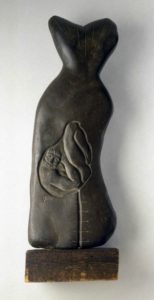The season of Lent invites us to wrestle with the realities of death and the hope of resurrection in creative, embodied ways. Here, Brittany Deininger, second-year MA in Theology & Culture student, writes about how a particular sculpture and the story of Jonah are leading her to consider imagination, creation, and the space between life and death in new ways.
On the fifth floor of the Brooklyn Museum sits John B. Flannagan’s sculpture, Jonah and the Whale: Rebirth Motif. Balanced on a woodblock base a sculpted bluestone whale holds the prophet Jonah carved into its belly. I am struck by the metaphor this hauntingly beautiful art piece provides for understanding imagination. In this particular cultural moment and in my work here at The Seattle School, I take imagination very seriously. Though often undervalued, and misunderstood, it is a source of robust hope for me and informs my way of being in the world. Using Flannagan’s sculpture of Jonah, I want to share three major capacities that I think imagination gives us: (1) the capacity to create in relationship and response to chaos, (2) the capacity to dwell in liminal spaces with prophetic hope, and (3) the capacity to liberate and re-vision what is possible.
 To say that humanity bears the imago Dei causes artists of faith to linger over theologies of creation and pay close attention to how humanity reflects the imagination and creativity of God. Genesis opens with the words, “In the beginning when God created the heavens and the earth, the earth was a formless void and darkness covered the face of the deep…” (Genesis 1:1-2). Theologian Catherine Keller, in her book Face of the Deep: A Theology of Becoming provides an interpretation whereby God does not create out of nothing, ex nihilo, but instead goes face to face with chaos and broods over the face of tehom (תְּהוֹם), “the deep.” It is this same word tehom that appears in Jonah’s story as he says, “Out of the belly of Sheol I cried, and you heard my voice. You cast me into the deep, into the heart of the seas…” (Jonah 2:2-3). The whale in Flannagan’s sculpture is nose-down, conveying a momentum of submersion and invoking the feeling of the watery deep that returns us to the beginning of creation. In a sense, Jonah is returned to the chaos to undergo a re-creation, a transformation into new life.
To say that humanity bears the imago Dei causes artists of faith to linger over theologies of creation and pay close attention to how humanity reflects the imagination and creativity of God. Genesis opens with the words, “In the beginning when God created the heavens and the earth, the earth was a formless void and darkness covered the face of the deep…” (Genesis 1:1-2). Theologian Catherine Keller, in her book Face of the Deep: A Theology of Becoming provides an interpretation whereby God does not create out of nothing, ex nihilo, but instead goes face to face with chaos and broods over the face of tehom (תְּהוֹם), “the deep.” It is this same word tehom that appears in Jonah’s story as he says, “Out of the belly of Sheol I cried, and you heard my voice. You cast me into the deep, into the heart of the seas…” (Jonah 2:2-3). The whale in Flannagan’s sculpture is nose-down, conveying a momentum of submersion and invoking the feeling of the watery deep that returns us to the beginning of creation. In a sense, Jonah is returned to the chaos to undergo a re-creation, a transformation into new life.
My sense is that the faculty of imagination, like Keller’s tehomic theology, does not create out of nothing, but creates in relationship and response to chaos. Writer and educator Parker Palmer in his book Let Your Life Speak even suggests that, “…chaos is the precondition to creativity…Even what has been created needs to be returned to chaos from time to time so that it can be regenerated in more vital form.” Keller’s reading of the creation myth also points toward this vital growth as she writes, “I mark ‘the beginning’ as a beginning-in-process, an unoriginated and endless process of becoming: genesis.” The quality of imagination required to inhabit this kind of work of transformation and becoming is one that does not seek to escape suffering and must not flee the chaos or unbounded mystery of the world. Instead our task is to respond and participate in the process of becoming, brooding over the waters of our own deep.
One of the most striking things about Flannagan’s interpretation of the story of Jonah is reflected in his depiction of Jonah’s body. Not only is Jonah in the belly of the whale, he is curled tightly in the fetal position to evoke the image of an impregnated abyss, the womb, the ultimate liminal space. The image holds the tension between tomb and womb, death and life. To stand in the tension of the “already” and the “not yet” is often the task of prophets, pastors, artists, and healers. The discipline and ministry of remaining in liminal spaces demands a hope that is both empathetic in attending to reality as it is and prophetic in beginning to vision it afresh. We might understand the phenomenon of hopelessness as a kind of suffering of the imagination, an inability to see otherwise. Art therapist Stephen K. Levine in his book Poiesis: The Language of Psychology and the Speech of the Soul writes, “There is no reality that is alive, without embodied imagination, that capacity to see otherwise.” It is the imagination that invites us to “see otherwise,” to sit with suffering in a new way, and to find instead of a deathly holding place of the tomb, the image of rebirth and the womb.
It is the tacit presence of God in Flannagan’s image of Jonah that is intriguing to me. The art piece marks a key pivoting point in the story, but also evokes the narrative of liberation: on the third day Jonah is freed from death. As we’ve heard from the text, in the midst of disaster, Jonah cries out to God and God hears him. In a moment of extreme powerlessness, Jonah reorients himself under the power of God, rather than under his own power, or under the domination of the circumstances. In this same way, part of the work of the imagination is to subvert the powers of domination that diminish the voice and personhood. How do we respond in times of domination, trauma, and hopelessness? How shall we meet the void? As an artist, I consider the practice of creating to be among the ancient forms of crying out, of praying in the language of the present moment. While fantasy might take us away from the world, a robust imagination leans us into the world to howl at injustice, name wounds, and re-vision what is possible beyond this present moment.
Photo Credit: John B. Flannagan (American, 1895-1942). Jonah and the Whale: Rebirth Motif, 1937. Bluestone with wood base, 30 1/4 x 11 x 2 1/4 in. (76.8 x 27.9 x 5.7 cm). Brooklyn Museum, Bequest of Edith and Milton Lowenthal, 1992.11.12 (Photo: Brooklyn Museum, 1992.11.12_SL1.jpg)

